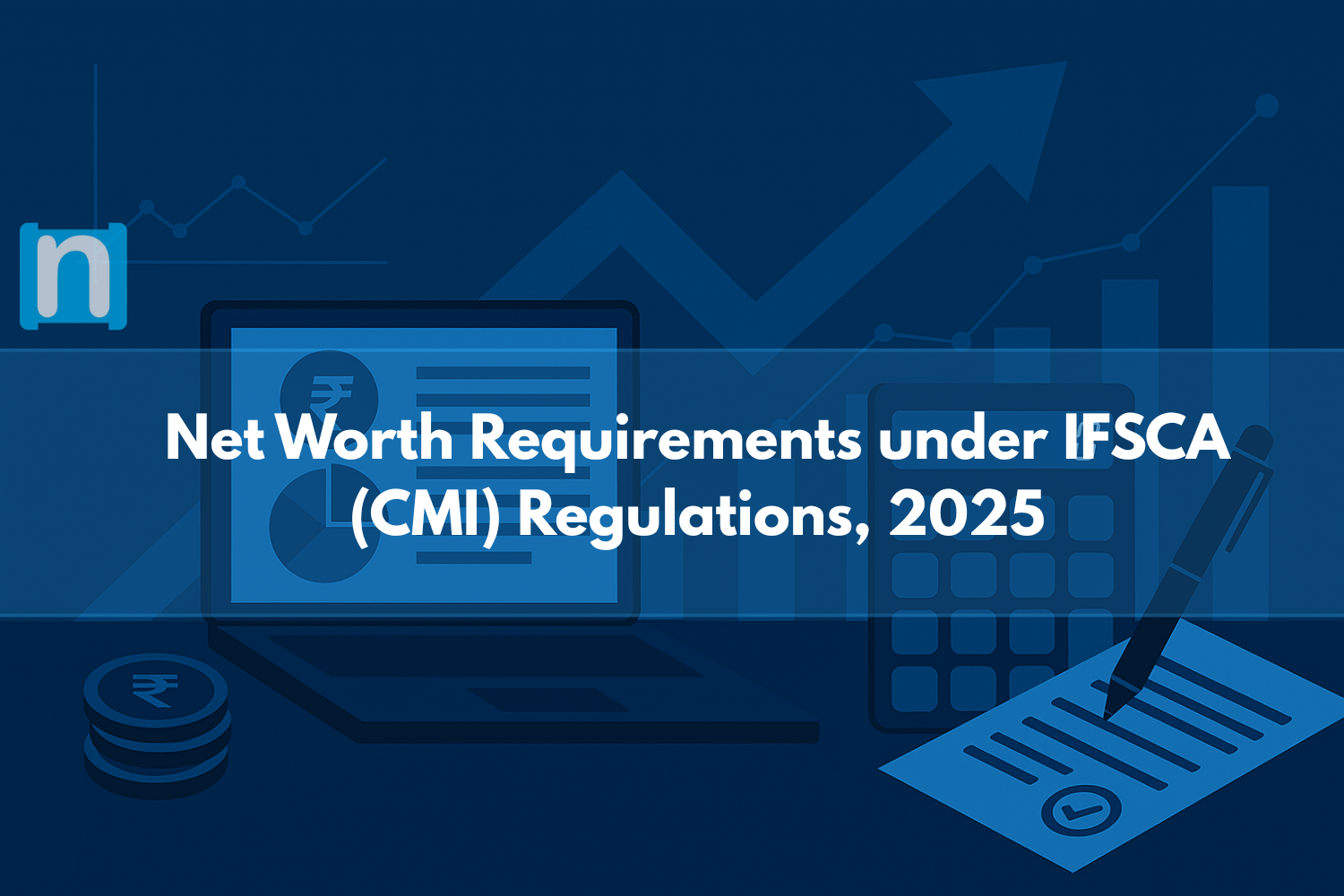Net Worth Requirements under IFSCA (CMI) Regulations, 2025
Table of Contents
ToggleThe International Financial Services Centres Authority (IFSCA) introduced the Capital Market Intermediaries (CMI) Regulations, 2025 as a comprehensive framework for entities operating in GIFT City IFSC. A central pillar of this regulation is the net worth requirement, designed to ensure that intermediaries maintain adequate financial strength, instill market confidence, and safeguard investor interests.
Originally, entities were required to comply by October 1, 2025; however, IFSCA has extended the deadline to December 31, 2025. This article provides a structured guide to net worth requirements, compliance principles, and practical FAQs for IFSCA-registered entities.
Why Net Worth Matters in GIFT City Compliance
Net worth under IFSCA is more than a licensing criterion, it is an ongoing compliance standard. Maintaining the prescribed levels at all times ensures:
- Financial stability of intermediaries.
- Risk management in volatile capital markets.
- Trust for global investors and regulators.
- Eligibility for registration and renewals.
Defining Net Worth under IFSCA CMI
Standard Formula
For most intermediaries, net worth = paid-up share capital + free reserves – accumulated losses – miscellaneous expenditure not written off.
Special Case: Broker Dealers, Clearing Members, and Investment Bankers
For these categories, net worth must be computed only on the basis of liquid assets, such as:
- Cash and bank balances.
- Fixed deposits.
- Government securities (G-Secs).
- Other instruments permitted by IFSCA.
Excluded items: Revaluation reserves, write-back of depreciation, and amalgamation reserves.
Minimum Net Worth by Category
The following thresholds are prescribed in Schedule I of the CMI Regulations, 2025:
| Category | Minimum Net Worth Requirement |
|---|---|
| Broker Dealer (Trading Member) | As specified by the recognised stock exchange |
| Clearing Member | As specified by the recognised clearing corporation |
| Credit Rating Agency (CRA) | USD 200,000 |
| Custodian | As specified by IFSCA |
| Debenture Trustee | USD 1.5 million |
| Depository Participant (DP) | As specified by the recognised depository |
| Distributor | USD 50,000 |
| ESG Ratings & Data Products Provider (ERDPP) | USD 25,000 |
| Investment Adviser (IA) | USD 25,000 |
| Investment Banker (IB) | USD 100,000 |
| Research Entity | USD 25,000 |
Global Access Providers (GAPs) – Special Category
The Global Access framework allows intermediaries to provide trading access in international exchanges through GIFT IFSC. For GAPs, specific net worth thresholds are prescribed by IFSCA, which must be:
- Segregated and earmarked for the Global Access activity.
- In addition to any other net worth maintained for other registrations.
Illustratively, higher-tier GAPs are expected to maintain a minimum of USD 500,000, while lighter models have proportionately lower requirements (as per IFSCA circulars).
Key Compliance Principles
- At all times compliance: Net worth must never fall below prescribed levels.
- Highest requirement rule: If holding multiple CMI registrations, the entity must maintain the highest applicable net worth.
- Branch model for foreign parents: Net worth can be maintained at parent level but must be earmarked for the IFSC branch, with documentary evidence.
- Separate requirement: CMI net worth is in addition to any domestic or overseas obligations.
- Record-keeping: Maintain quarterly net worth statements and audited annual financials as evidence for inspections.
Transition Timeline – Extended to December 31, 2025
- Original deadline: October 1, 2025.
- Extension granted: IFSCA circular extended compliance to December 31, 2025.
- Practical implication: Entities should finalize capital infusions, obtain board approvals, and update compliance records before year-end.
FAQs on Net Worth Compliance
- What counts as liquid assets under IFSCA?
A. Cash, bank balances, fixed deposits, government securities, and other instruments notified by IFSCA. - How should foreign parent entities earmark net worth for IFSC branches?
A. By maintaining board-approved allocations and providing supporting documentation that clearly identifies funds reserved for the IFSC branch. - If an intermediary holds multiple registrations, how is net worth calculated?
A. The entity must comply with the highest net worth requirement among its registrations.
Expert Insights – Our Experience at N Pahilwani & Associates
With 15+ years of professional service experience, N Pahilwani & Associates has been at the forefront of advisory and compliance in GIFT IFSC.
- Experienced team: Chartered Accountants (CAs), Company Secretaries (CS), and Registered Valuers.
- Office presence: GIFT IFSC (Signature Building) and Vadodara, Gujarat
- Practical expertise: Already engaged in issuing net worth certificates for IFSCA-registered entities.
- Trusted partner: Advisory support across compliance, audit, tax and capital market intermediary regulations.
Our experience allows us to provide practical, regulator-aligned solutions for intermediaries navigating IFSCA’s evolving landscape.
Conclusion – Preparing for Net Worth Compliance
The net worth requirement under IFSCA’s CMI Regulations, 2025 is more than a regulatory formality, it is a strategic foundation for credibility and business growth in GIFT City. With the compliance deadline extended to December 31, 2025, now is the time for registered entities to assess readiness, shore up capital buffers, and streamline documentation.
Contact N Pahilwani & Associates for a readiness review, certification support, and tailored advisory solutions for seamless compliance with IFSCA net worth requirements.



